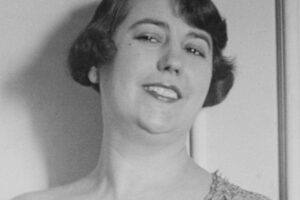

So imagine me at twenty, dropping the György Ligeti Grand Macabre I’d just bought at Tower Records into my CD player and as this insane music, by one of the late 20th century’s greatest masters, comes stampeding out of my speakers, over my head a thought balloon should appear that says What in the hell is wrong with us that this has never been performed in the United States?
Well, that was then. Pamela Rosenberg brought this crazy thing to the States, finally, and now Alan Gilbert has brought it to New York with projections and costumes and props—a “fully staged” performance, as the Phil started calling it as the program drew closer, or at least as fully staged as it is possible to do in Avery Fisher. It sold out! Everybody who was anybody went to see it! All your favorite blogospheroids were there Friday: I saw parterre’s own Squirrel and Maury there, and Pianist/blogger Jeremy Denk, who was perhaps doing a little homework for his forthcoming performances of Ligeti’s gonzo Piano Etudes.
And I, although I could hardly believe it, was there. So after spending a decade or so obsessing over the recording (the Sony recording. What, you think I’m gonna pay like $50 for the Wergo recording, if I already have a recording of the revised version? Sure I’m a Ligeti nerd, but I’m not THAT bad, YET) and after spending just a few days ruminating over my first-ever live experience of the opera, here is Danny‘s take on Le Grand Macabre.
First: the score. The work is positioned at a transitional moment in Ligeti’s oeuvre, between his famous 60s textural experiments and the more rhythmically driven, more classically influenced works of his late period, and it not only sums up his musical language up to that point but introduces a few elements — parodies of classical as well as more demotic styles — that help make Le Grand Macabre rather more accessible than much of his work for the concert hall (these things being relative. I witnessed a few walkouts, and most of my own neighbors seemed to have disappeared after the intermission, although to be fair this was only a fraction of the otherwise steadfast, sold-out crowd).
But again, just about everything you’ve ever enjoyed about Ligeti’s music, if you’ve ever enjoyed Ligeti’s music, is on display here. To start with the vocal writing — Ligeti is one of those composers who in the late 20th century became fascinated by the gap between the “ideal performance” and the actual capabilities of human beings; some of the vocal lines are written in such a way to suggest that it’s less important to hear each 16th note of pitch content than it is to hear very good singers struggle very hard to keep up with the score. If the singers are great, it’s a stunning display of athleticism, and honey, the singers were great (more on this in a bit).
And then all of that gets chucked out the window in favor of eerie, luscious beauty, where the singers have to make an incredibly pure sound, like the overtones of distant bells, and the orchestra reaches into such high and low frequencies your ears start playing tricks on you. At those moments in the plot when the characters’ repetitive compulsions turn them into mindless clockwork automatons—repetitively tossing back cups of wine or chanting the praise of their political leaders—the music switches into yet another mode and recalls the gradual rhythmic processes of, say, Steve Reich, whom Ligeti admired (although he protested that he’d come to much the same conclusions as Reich on his own, at around the same time, without knowing his work).
I said “plot,” just now, and yes there is a plot! Ligeti recognized a trend among his colleagues to write “anti-operas,” I guess operas whose self-consciousness made them eat themselves up by the tail, and while he’d produced two efforts in that genre—his brief “comic strip operas” Aventures and Nouvelles Aventures, in which characters with no names spout gibberish and have nonsensical interactions—he wanted to write an “anti-anti-opera,” and I guess he succeeded? There are indeed characters in this opera, although they are barely recognizable as human; there is a sequence of events, although it might sometimes seem sketchy or arbitrary. The libretto was cowritten by a puppeteer, which gives us a clue as to how to read the libretto: as a sort of R-rated Punch & Judy show.
Beyond the puppet theater, the other looming influence on the story is Lewis Carroll, whose Alice in Wonderland was a lasting obsession of Ligeti’s—he set a bit of Carroll in the excellent Nonsense Madrigals, and though he died before beginning work on a long-planned Wonderland opera, there are vestiges of it in Le Grand Macabre, starting with the setting: the opera takes place in “Breughelland,” as if to suggest a Wonderland imagined by Breughel the Elder. But the outsider who wanders through this nightmarish landscape isn’t a precocious little girl, it’s Death himself, Nekrotzar, come to end the world. And instead of logical conundra it’s dick jokes.
Along the way, Nekrotzar encounters Amando and Amanda (a pair of narcissistic lovers, one a trousers-role, fucking in the graveyard), Piet the Pot (a drunkard), Astradamor (Royal Astronomer and CD/TV BDSM sub), and Astradamor’s abusive wife Mescalina (heh!), before saying take me to your leader and ending up in the farcical court of Prince Gogo, Breughelland’s ineffectual boy ruler. Nekrotzar there attempts to bring about the end of the world, but after a few toasts too many, misses his deadline, or fails, or else the rotten world just refuses to die — it’s not entirely clear — at any rate, it’s the end of the world as they know it, and everybody feels fine.
Somewhere in there, there’s an amazing hallucination of Venus, the planet and/or goddess, and a stammering coloratura secret police chief, and two corrupt ministers, and also three soldiers who probably could’ve been written out of the plot entirely and nobody would be the wiser.
Le Grand Macabre, like Dialogues des Carmelites (aren’t you curious to hear how this sentence will end?), was intended by the composer to be performed in the language of the audience, which in the age of Met Titles is maybe not the best idea, unless your audience is actually illiterate, because singing translations are the WORST. I’m guessing this policy of Ligeti’s results from the relatively disastrous premiere (in Sweden, for an international audience) of the original version, which was a Singspiel with spoken Swedish dialogue that to the assembled body of non-Swedes sounded like hurdy-hurdy-flurdy and nobody got the jokes.
Still, yikes: when the Amando of the English translation thinks he’s caught Piet peeping on his graveyard tryst with Amanda, he damns him with a “Stupid dickhead / Make your prick red!” which seriously people? That is so ugly and stupid and makes no sense and doesn’t even reflect the original German. And when the libretto is this gleefully stupid, you know I’m really saying something when I complain that the translation doesn’t do it justice.
Fortunately, the translation was revised for this performance (“Peeping prickhead / Stupid dickhead!” ran the offending lines, which at least makes some kind of sense), but the projections mystifyingly failed to include supertitles. To make up for it, the audience was handed a complete, handsomely printed complete libretto with the program—but the libretto was printed in white on black, totally unreadable in the dark. And with singing translations, you can barely tell what anyone is saying anyway, since duh they’re opera singers, and also they’re singing music that was designed to bring out the rhythms and inflections of a totally different language, and their syntax has been twisted into pretzels in order accommodate poetical meters totally hostile to English.
The projections were great, though! True to the piece’s origins, the production was created (by Doug Fitch and Giants Are Small) as a sort of puppet show, with miniature sets and images projected larger than life on a screen hanging above and behind the action. Think Méliès visits Pee-Wee’s Playhouse. The projections not only lent clarity to a staging obstructed by the presence of a massive symphony orchestra, they also offered moments of real wit—maybe more wit than the actual libretto. When Mescalina thinks she’s accidentally murdered her husband, for instance, she launches into a disingenuous, quasi-Baroque lament; on the screen above her, a disembodied puppet hand began hawking diamond rings on a cardboard-cutout home shopping channel, as if to suggest just how profound her sense of loss really is (not very!).
One of my friends complained that the work couldn’t be sold as a “fully staged” production if there was a full orchestra sharing the stage with them; I hesitate to complain, since there was a full stage with a trapdoor and all the props and costumes and elaborate business. The chorus, like the orchestra, was dressed in the solid black of a pit band, but when they were called upon to play a role in the drama, they moved and acted and interacted just as fully as if they had been costumed characters. Another of my friends complained that the production looked “cheap,” but I think that the shoestring quality of the visuals actually contributed to my enjoyment of them — as in any puppet show, part of the pleasure was seeing the variety of effects derived from limited means.
At any rate, it was totally necessary to present this piece with props and business. It would be irresponsibly dull to put on an opera so heavy on slapstick and sight gags in a concert version.
The costumes were cleverly conceived as well. Gepopo, head of the secret police, written as a truly demented trousers role for coloratura soprano — like Thomas Adès‘s depiction of Ariel in The Tempest, which it surely inspired — was instead portrayed as a malfunctioning lady cyborg, recalling Fritz Lang‘s Metropolis (with maybe a dash of Bart Sher‘s Contes d’Hoffmann?). Prince Gogo wore a spherical costume resembling an enormously magnified drop of milk, and his two battling Ministers (leaders from the Black and the White Parties — no no, they’re POLITICAL parties, not, you know) duked it out in top hats, tailcoats and boxing gloves.
But I disliked the style in which they and the other visual designs were executed, which for me recalled the Wonderland not of Carroll but of Tim Burton‘s ugly film. The obvious benchmark here is William Kentridge‘s Nose for the Met, which also made novel use of projected paper puppetry, but which exploded with delicious visual style. (At the time, our own Straussmonster pointed out a certain affinity between these two scores themselves, which I thought rather astute.) I loved it! Gesamtkunstwerk, baby.
These designs, on the other hand, turned out a little more like Julie Taymor‘s Magic Flute costumes — genius in concept, tacky onstage — than the visual elements from Kentridge’s production. Well y’know what, that was William Kentridge, so it’s already unfair, and now I’m gonna go out on a limb and guess that his production cost a LOT more than this one, so yeah, suck it up.
The singers’ dramatic performances were wholly committed, but seemed a little under-directed, so that once or twice it was unclear what exactly was going on (e.g. Venus’s appearance, or the lovers’ cemetery slapstick with Piet), and sloppy clowning is such a drag. Still, they did give their all, and their all was an awful lot.
It really seems impossible to summarize the outstanding achievements of a uniformly stellar cast. Mark Schowalter, as Piet, sang the unsingable, his part punctuated with atonal passagework and screaming and hiccuping and flights of falsetto, and he had to act drunk and get beaten up and then ridden like a horse across the stage. He never faltered.
Anthony Roth Costanzo, as Prince Gogo was outstanding, too. On the Sony disc, his part was sung by countertenor Derek Lee Ragin, that dependable ruiner of otherwise excellent John Eliot Gardiner recordings, and — not knowing much about singing, really, and especially not about the special challenges of writing for this voice type — I wondered whether it might just be impossible to sing the role with a bright and pleasant tone. I am delighted to report that it is not only possible to do so, it is furthermore possible to alternate between articulate delivery of complex quasi recit with lines of exquisite lyricism, and then follow it up with some hilarious clowning in extreme close-up. It would be too easy for Gogo, an essentially weak character, to turn into a sort of nothing onstage, but he remained a sympathetic presence, and managed to keep the audience’s attention when the emphasis of the action moved from the impending destruction of the world towards some not especially pointed political satire.
I knew Eric Owens mostly from his performance in Doctor Atomic, in which the bullying Gen. Groves’ grim eagerness to unleash destruction of cataclysmic proportions was humorously offset by his apparent inability to control his personal appetites. So, basically the same as Nekrotzar. Our first glimpse of him is a bona fide coup de theatre, his head popping out of the miniature set, projected to giant size on the screen overhead, to glower at the creepy love-couple from within the mouth of a tomb. (That glower was priceless; he and the production got a well-earned laugh.) He radiated presence in our last glimpse of him as well—a beaten man in shabby undergarments—and of course, even more so throughout the bulk of his performance, in Nekrotzar’s full, glorious raiments. (It seemed, especially compared to all of these lovely flourishes, a poor choice to have him walk on in what looked like street clothes; his presence was diminished, but not comically so. He just looked out of place.) Vocally, he thundered, bellowed, and crooned, fearsome and funny and lovely.
And then there were THE LADIES. Venus and Gepopo are both short, very high coloratura roles, so Audrey Elizabeth Luna learned them both just in case; she was the cover who ended up singing Venus, and her voice shined like the Moon, or like Venus, whichever pun you prefer, and she spent the whole time singing on stilts in a floor-length gown. Barbara Hannigan, as Gepopo, stunned the crowd with her combination of wild vocal acrobatics and stage hysterics—she actually descended into the audience, walking like a robot, waving a gun, and fired off a round or two. (Remember when I said they were “fully committed”? Yeah.)
But for me, the greatest source of dazzlement was still the orchestral writing. Having heard the piece a thousand times on record, the live experience was nevertheless something entirely new. The band was huge, including every imaginable species of contrabass whatever and percussive doodad, even (most notoriously) a full rank of old-fashioned carhorns that made the guy next to us jump as soon as the baton came down. (The battery of door buzzers for the second act, though, were obviously sampled. BOO!)
Ligeti, and Gilbert, fully exploited the space, utilizing offstage choruses and consorts at every corner of the house. When the time came for Nekrotzar to make his (mock-) grand entrance into the royal palace, he was followed by a pitiful band playing a demented march, and on the other side of the hall, a bass trumpet(!) played a sinister fanfare, and then the musicians onstage began to join in, and something happened that I didn’t expect at all: I was overwhelmed. I was stirred, elevated, by the enormous — grotesque — beauty of the experience. It’s been days now since the performance, and I’m still savoring the afterglow of this one moment. It was like nothing I had ever heard before. I want to see it again. May I see it again, please?
The applause at the opera’s close, if you’re wondering, went on forever.
That Le Grand Macabre has taken so long to reach the stage in New York City is a disgrace, and Alan Gilbert’s decision to put on a “fully staged” performance is a rebuke to the longstanding Manhattanite provincialism of Lincoln Center. True, it is the duty of American opera houses to nurture our native composers, but does that mean our audiences should remain ignorant of the music being made across the ocean? Do you remember the last time that the Met put on a new European opera? Why has New York never seen the ravishing operas of Berio or Messiaen? Saint François would certainly work very well in this kind of a presentation; I don’t think Un re in ascolto really needs a set, as long as it has singers and stage business.
But now I’m just playing fantasy baseball with the other operatic obsessions of twenty-year-old me. Cunning Little Vixen is scheduled to receive this treatment next season, and that seems like a great choice—an opera where people play woodland creatures is a perfect fit for a theatrical presentation that works just a little magic with problems of physical scale.
We all know that the Phil, much like every other arts institution in the country, is having money problems, and a show like this, even with three sold-out houses, is almost a recipe for red ink. But it’s thanks to shows like this that the Phil is accomplishing something under Alan Gilbert that it hasn’t managed in quite a long time: it’s positioning itself, once more, as an essential part of American cultural life.

























Comments